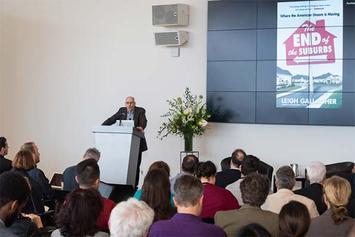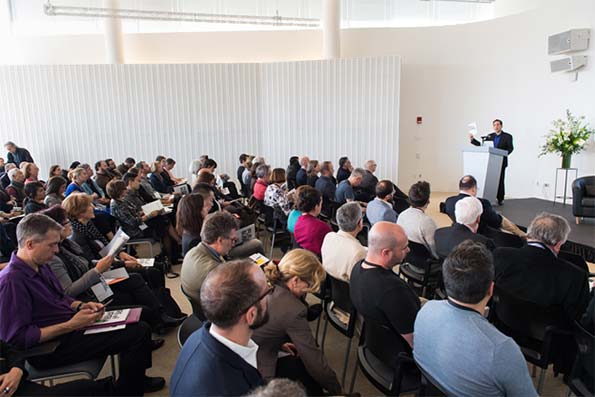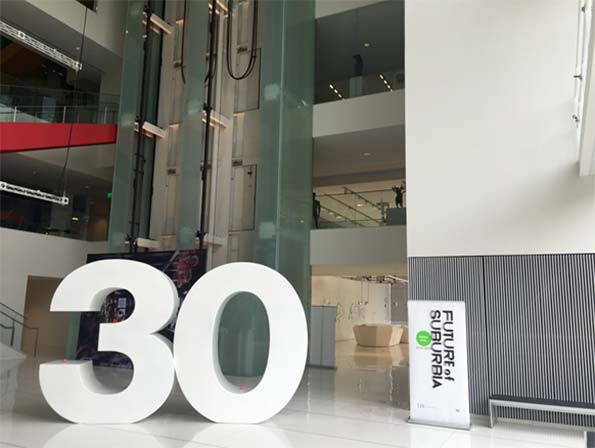
In the United States, over 69 percent of all residents live in suburban areas. Across the globe many other developed countries are primarily suburban, while developing countries are increasingly suburbanizing. By 2050, an additional 2.7 billion people are anticipated to live in metropolitan regions around the world, and suburbs are a significant portion of this urban expansion. Over the past two years, 150 experts from numerous, diverse disciplines contributed research that explores this contemporary global phenomenon – and on April 1st their work was showcased at the MIT Media Lab for the Future of Suburbia conference.
The “Future of Suburbia” was chosen as MIT’s Center for Advanced Urbanism biennial theme in order to shed light on the growing role suburbs play in our lives and how they may be improved for the future. Suburbia is an often polarizing issue that should no longer be ignored by the fields of Planning and Design.
The conference is just one of three products the Center for Advanced Urbanism created for its biennial research theme. An exhibition, located on the ground floor of the MIT Media Lab included infographic mappings, a 22ft x 8ft dynamic model of a 3 million population polycentric region in the year 2100, and aerial footage of global suburbs. The third product, a publication entitled Infinite Suburbia (Fall 2017), brings together 50+ authors and about 700 references, providing groundbreaking research on our low-density future.
Each of MIT’s five schools were represented at the conference, spanning twelve key fields. Attendees also included students from Harvard and Chapman University, and speakers in demographics, entrepreneurship, history, urban design and media production. The findings were presented within four design frameworks, including heterogeneous, productive, autonomous and experimental, which were explored through a variety of fields; including design, architecture, urban planning, history and demographics, policy, energy, mobility, health, environment, economics, and applied and future technologies.
The conference centered on the question, how might suburbia be upgraded to better suit our needs? Can new suburban models be created for developed, but also developing, countries? What challenges will suburbs face in the future? Despite such a large and complex topic, enlightening data, opinions and predictions were given regarding suburbs and their role in a sustainable future.
Forgetting the Urban-Suburban Divide
The urban-suburban dichotomy is highly debated (in fact, urbanists and planners themselves use 200 different terms to describe suburbia), but the Future of Suburbia conference tried to stay above the fray, instead describing the two camps as one evolving continuum. Throughout the day points were made that the suburb and urban can and should learn from one another. Traditionally, we have failed to recognize just how important suburbia is in this country and globally. By polarizing the suburb and the city we ignore how the making of peripheries can greatly contribute to urban centers, and vice-versa. However, this conference did not focus on trying to define suburbia, but on how we should think of urbanization’s holistic impact.
Historian Robert Bruegmann kicked off the conference by outlining its history and persistence worldwide despite economic and political differences. Bruegmann finished his introduction by advocating that we be “more modest in what we think we know and what we plan for our future.”

The Suburbs as a Heterogeneous and Productive Form
The conference’s first panel of the day, on heterogeneity, dealt largely with numbers and trends. One statistic that stood out – 90 percent of Americans live in suburban areas, while only 10 percent live in urban cores. Also, 80 percent of Americans wish to live in a detached home. As millennials get older, more will be married and begin having children, making suburban living all the more desirable. In the United States, the denser the community, the fewer children there are. Just take a look at San Francisco, where there are more dogs than children and families are increasingly moving out of the city, or Manhattan, which has the lowest percentage of children in the country.
It is also the highly educated and majority white that are moving to city centers, while two thirds of millennials do not have college degrees. It seems that what people truly want in their hearts, is being mixed up with costs, in both the city and suburbs. Economist Jed Kolko described the process as circular – where do people want to go, what is the economic situation, and where are the externalities. Kolko admitted it’s hard to quantify how much demand for suburbia is an impact of policy, or consumers’ hearts.
Ali Modarres, director of Urban Studies at University of Washington Tacoma, presented on the suburbanization of immigrants, stating, “Immigration is redefining and complicating the word suburb”. He explained, “…suburbs, old and new, are more likely to become super diverse.” Why are immigrants moving increasing to suburbs and not city centers? Because suburbs are home to a growing working class population, seeking affordable housing close to emerging job centers. For example, Orange County and northern LA County have seen significant foreign born population growth. And David Rudlin, winner of the prestigious Wolfson Prize, has high hopes for the future of the polycentric city. He emphasized the importance of a strong economy in suburban settings, asserting, “If you don’t have the economic driver of a city, you end up with a dormitory.” He called for the open sourced suburb as a way for creating a bio-system that allows diversity to develop.
How can we design suburbs in a more productive, environmentally friendly way? The next panel explored this question beginning with Susannah Hagan, professor of Architecture at the University of Westminster, who emphasized that the suburban and urban are different, but should not be thought of as separate entities. The suburb can benefit the city, while the city, in turn, can benefit the suburb. Hagan also discussed strategies for post-industrial cities, to “manage degraded industrial spaces.” She talked about different types of seeds – actual plant seeds, investment seeds, and the concept of idea seeds for regenerating cities and suburbs.
Joan Nassauer, professor of Landscape Architecture in the School of Natural Resources and Environment at the University of Michigan, showed that suburbs can be environmentally productive places, making the point that by area, as much carbon is stored in Michigan’s southeast exurban residential landscapes as in the managed forests of North Country.
Mitchell Joachim, co-founder of Terreform ONE and associate professor at NYU, proposed that agriculture should be brought back into the suburbs which would create a “new kind of nature” that can shrink our ecological footprint. Innovative ecological designs such as living houses, urban farm pods, and cricket shelters were explored. The question then becomes, are suburban residents ready to break the model?

An Autonomous and Experimental Future
The main challenges of autonomy in the suburbs are regulatory, technical, and complicated by the user experience. But with the right tools, autonomy has the ability to transform the way people live and travel outside the city. Joseph Coughlin, professor and Director of the MIT Age Lab moderated the panel that included Knut Sauer of Hyperloop Technologies, Eran Ben-Joseph of MIT’s Urban Studies and Planning department, and Nick Roy of the Department of Aeronautics & Astronautics at MIT.
New technologies will change our lives, allowing us to travel from LA to San Francisco in 25 minutes, or purchase something in the middle of the night and have it delivered by drone within the hour. The ideas presented look promising – in just a couple years the Hyperloop will be a reality for human passengers. But the innovations may still need tweaking, since people tend to reach out to drones and dangerously interfere with their motors.
If these weren’t experimental enough, the next panel consisted of conceptual housing models and the creation of an entire city dedicated to testing. The experimental panel was moderated by ex-suburbanite and writer for the New York Times, Allison Arieff, who explained how she wanted to see cities and suburbs learn from each other rather than fight.
Paul Fieler laid out upcoming plans for CITE City, a New Mexico based model city that will be built to test, evaluate, and certify new urban technologies. The development will look and function as a real city, and thousands of people will move into the houses and apartments to conduct real-life experiments. David Neustein of Other Architects proposed another urban concept for Australia, the most suburbanized nation in the world. As the population ages and preferences shift towards sustainability, Neustein’s model would facilitate the downsizing of Australia’s many “McMansions” so that the elderly could rent out their second stories. It would also boost Australia’s housing stock and redesign facades to become more integrated into nature.
Meanwhile, Bob Geolas of the Research Triangle Foundation in North Carolina cities must understand what to embrace in terms of their brand, culture, and urban form. He outlined how the Research Triangle is overcoming its outdated research park form and building upon its values and strengths to become relevant in the economy and contribute to a sustainable future. Physical and programmatic collaboration, unique and relevant design, events and programs, and public spaces will all be key components for making the Triangle an attractive place to work in the suburbs.
Takeaways
Topics included innovation in cities, and economic and cultural trends, including immigration, demographics and lifestyle preferences, and how these forces interact in the urban, or suburban milieu. As population grows and technology improves, the researchers predict that the urban-suburban divide will disintegrate, resulting in a continuum of urbanity, one that takes form as a poly-nodal fabric of different hubs of innovation, living and sustainability.
Also, we learned how important it is for urban designers to collaborate with business leaders, economists, and city officials, and the community residents themselves to design and implement the most appropriate and beneficial suburban structures. These fields traditionally function in silos, but the future requires that these disciplines co-mingle in the creation of sustainable, productive, and creative places to live. If we focus less on the semantics of the urban-suburban divide, and channel our energies on creating better places to live for all types of people, more will benefit.
Alicia Kurimska is a researcher at the Chapman University Center for Demographics and Policy. She is a first generation American with a Slovakian background who graduated from Chapman University with a degree in history, writing her thesis on Czech President Edvard Benes’s struggle to preserve the Czechoslovak nation, inspired by her year-long studies at the Anglo-American University in Prague.
Charlie Stephens is a researcher at the Chapman University Center for Demographics and Policy, and an MBA candidate at the Argyros School of Business and Economics at Chapman University. He is also a regular contributor to the creative business site PSFK.com and the founder of substrand.com, a hub for sharing and discussing the creative, intellectual and emotional aspects of cities.
Photos by Justin Knight.












